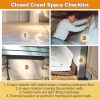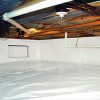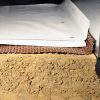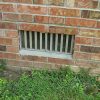![]() Some homeowners want to improve home energy efficiency because it’s a major element in greener living –a commitment to environmental awareness. Other folks are motivated by the cost savings you achieve. According to the Dept. of Energy, most houses use twice the energy they should. By making the right improvements, you could cut your annual energy expenses in half.
Some homeowners want to improve home energy efficiency because it’s a major element in greener living –a commitment to environmental awareness. Other folks are motivated by the cost savings you achieve. According to the Dept. of Energy, most houses use twice the energy they should. By making the right improvements, you could cut your annual energy expenses in half.
No matter what’s behind your desire to improve home energy performance, it’s not easy to decide what energy-saving upgrades to make on your house. There are plenty of sales pitches and special deals going on in every community –classic “silver bullet” solutions that promise amazing energy savings. Don’t believe everything you hear. Understanding the reality behind the seven myths discussed below will help you make smarter choices about energy-saving upgrades. These myth-busting realities are based on Building Science –the study of how different house systems (ductwork, insulation, HVAC equipment, windows, water heating) interact to influence not just energy performance, but also indoor air quality and the durability of different building components.
MYTH #1: Having replacement windows installed should be a top priority in any energy-saving plan.
REALITY: Having energy-efficient replacement windows installed will cut your heating and cooling costs, especially if your house has old single-pane windows. But since a whole-house window replacement project could cost $15,000, it will take many years for this investment to pay for itself. Air-sealing and insulating the attic of the same house would probably cost around $4000. But this smaller investment has been shown to cut heating and cooling costs by as much as 40%. This attic upgrade could pay for itself in just a few years (or faster, if fuel prices continue to rise).
MYTH #2: When replacing HVAC equipment, it’s smart to have slightly oversized systems to ensure optimum performance at all times.
REALITY: Oversizing HVAC systems is a rule of thumb that contractors have applied for many years. But today it’s recognized as bad practice –a strategy that wastes energy and actually causes comfort problems. A jumbo AC system can supply so much cool air so quickly that the thermostat will turn the system off before a sufficient amount of cool air reaches certain parts of the house. Making matters worse, the oversized AC unit may turn off before enough moisture can be removed from the air. Like a car engine, an HVAC system doesn’t operate at peak efficiency as soon as it turns on. Operating in short cycles rather than at “cruising” speed robs the system of efficiency. Similar problems occur with an oversized heating system. For much better performance, the HVAC contractor should “right-size” a home’s HVAC system after air-sealing and insulation upgrades have been completed. Because of its more airtight, better-insulated building envelope, the home’s new HVAC system can be significantly smaller than the old one. It will cost less to purchase than an oversized system, and less to operate, too.
MYTH #3: Newer homes are more energy efficient than older homes.
REALITY: Today we have the knowledge and the products to create exceptionally efficient homes. It’s even possible to build “zero-energy” houses that generate as much energy as they consume. Unfortunately, the building codes used in many communities focus on minimum performance standards that ignore the impressive advances we’ve made in building technology. Low standards ensure lower prices and plenty of work for contractors who specialize in energy-efficient retrofitting. It’s sad but true: A new house can be just as much of an energy hog as an old one.
MYTH #4: A house needs to breathe; it shouldn’t be too airtight.
REALITY: The fact that the EPA has identified indoor air pollution as a major health concern might lead you to advocate against airtight construction techniques. But extensive testing has proven that you can have your cake and eat it too: a “tight” house that conserves energy but preserves indoor air quality with mechanical ventilation. Heat recovery ventilators (HRVs) and energy recover ventilators (ERVs) are two commonly used HVAC components in tightly built, well-insulated houses. They are designed to exhaust stale interior air while drawing in a balanced volume of fresh outdoor air. Hi-tech kitchen and bath fans are also available to promote healthy ventilation rates.
MYTH #5: An attic fan will cut air-conditioning expenses by exhausting hot air from the attic.
REALITY: The second part of this statement is true: Powered attic ventilators (PAVs) do indeed exhaust hot air from the attic. Unfortunately, a PAV doesn’t discriminate about the air it moves. The suction caused by the fan can also pull conditioned (cooled) air from the living space into the attic. A better strategy to protect your living space from high attic temperatures is to beef up attic insulation and make sure the attic has adequate passive (no electricity required) ventilation provided by a combination of soffit, gable and ridge vents.
MYTH #6: Energy-saving improvements like air sealing, insulation and an energy efficient furnace won’t improve a home’s resale value because they’re features that prospective buyers can’t see.
REALITY: It’s true that an extra thick layer of cellulose attic insulation doesn’t have the “wow” value of a jetted tub or new kitchen cabinets. But don’t underestimate the impact of your home’s utility bills. Knowing that a home will be affordable to own is a strong selling point. Real estate agents in many parts of the country report that “green” homes with energy-efficient features sell faster and for higher prices than homes without such features.






